Published:
Author: Antonio Maria Guerra
Pandoro

Pandoro is, together with Panettone, one of the ‘classics’ of the Italian Christmas holidays. It’s a simple dessert, with an austere personality. The specialty owes its enormous success to the elegance of its taste and appearance, characterized by the typical golden reflections. Let’s find out the origins of this sweet delicacy, how it’s made and many interesting curiosities. Enjoy the reading!

What is Pandoro?
‘Pandoro’ is one of those desserts that cannot be missing on the Italian tables during the Christmas holidays. Originally from the city of Verona, it’s easily recognizable by its typical truncated cone shape, with an eight-pointed section, clearly recalling that of a star. Although it requires just a few ingredients (including flour, eggs, butter and sugar), their processing gives birth to a soft specialty, with a unique taste and golden reflections: a true ‘Golden Bread’ (‘Pan d’Oro’), hence its name.
Verona: the city of Pandoro.
Verona, the city of Romeo and Juliet, is also the birthplace of Pandoro. It’s located in Veneto region, in the north-east of the Italian peninsula.


The history of Pandoro.
 ‘Pandoro’, as we know and appreciate it today, is one of the very few desserts whose date of birth can be identified with certainty: the 14th of October, 1894. It was precisely on that day at the end of the century (*1) that the Veronese pastry chef Domenico Melegatti filed the patent for his exquisite invention, easily recognizable by its typical truncated cone shape, with an eight-pointed star section (*2).
‘Pandoro’, as we know and appreciate it today, is one of the very few desserts whose date of birth can be identified with certainty: the 14th of October, 1894. It was precisely on that day at the end of the century (*1) that the Veronese pastry chef Domenico Melegatti filed the patent for his exquisite invention, easily recognizable by its typical truncated cone shape, with an eight-pointed star section (*2).
If all this is indisputable, what continues to elude experts and admirers is the source of inspiration that guided Mr. Domenico.
There are many views on the subject: some, digging into the distant past, claim that the ancestor of the specialty could be a ‘panis’ (‘bread’) with golden reflections dating back to the 1st century AD, made with butter, flour and oil by the cook Vergilius Stephanus Senex and mentioned several times by the famous writer Pliny the Elder.
Read more
 Without going so far into the past, it’s impossible not to mention the ‘Levà’: a dessert once made in Verona on Christmas Eve and which consisted of a leavened dough covered with a grain of sugar and almonds.
Without going so far into the past, it’s impossible not to mention the ‘Levà’: a dessert once made in Verona on Christmas Eve and which consisted of a leavened dough covered with a grain of sugar and almonds.
It’s also important to remember the many types of ‘Pan de Oro’ (‘golden bread’) and ‘Pan di Natale’ (‘Christmas Bread’) that, with similar recipes, followed one another over the years: above all the one prepared in the female monastery of San Giuseppe in Fidenzio (*3).
What Melegatti really did was to ‘lighten up’ the Nadalin, making it softer. By taking out the cover, he allowed his specialty to rise, developing vertically (*7) and thus making the evolution of the dessert even more evident. The shape itself, with eight points, would be nothing more than a ‘modernization’ of the original. Thanks to the immediate success of Pandoro, Melegatti founded a renowned confectionary company that still today exports the delicacy all over the world.
*1: In truth, the specialty had already been advertised at least a year earlier, with an announcement inviting to purchase the ‘exquisite Pan d’Oro’.
*2: The shape was designed by one of his friends: the impressionist painter Angelo Dall’Oca Bianca;
*3: The ‘Christmas Pan’ indicated many times by Andrea Brugnoli, a great expert on the subject;
*4: The Della Scala family ruled over the city of Verona for 125 years, from 1262 to 1387;
*5: In 2012 ‘Nadalin’ received the De.C.O. certification, Municipal Denomination of Origin, a legal instrument used to valorize and protect a particularly typical product;
*6: ‘Nadalin’ has still today a large number of admirers, especially among the people from Verona who, after the international success of Pandoro, consider Nadalin more typical.
*7: It’s definetly possible that, by facilitating this ‘raise’, Melegatti followed the canons of the Austrian pastry shop. Not a coincidence, considering that the city of Verona had been under the control of the Hapsburg troops for a long time.
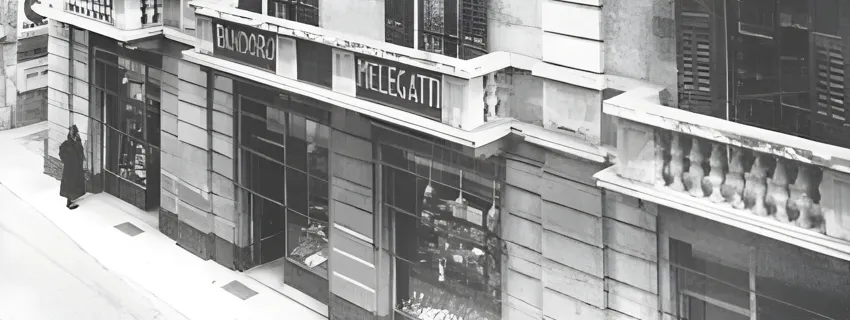
Pandoro by Melegatti.


How is Pandoro made? (hints)
Although the number of ingredients is limited, making Pandoro is not a simple task: reaching a good result requires experience and great accuracy in the preparation. We will not provide the complete procedure but just some hints to get an idea.
Read more
INGREDIENTS: 00 flour, eggs, butter, water, brewer’s yeast, sugar (granulated and powdered), honey, vanilla, grated lemon and orange peel;
PROCEDURA:
01 – FIRST DOUGH: Combine water and brewer’s yeast. Add the flour and mix everything. Let the dough rest for a few hours;
02 – SECOND DOUGH: Add more flour, sugar, and chopped brewer’s yeast to the dough. Knead it and add the eggs (both red and white);
03 – The dough has to rest at room temperature so that it rises. Then place it in the fridge;
04 – At this point, it’s time to make an aromatic mix which, in addition to vanilla, can contain, for example, honey and grated orange and/or lemon peel;
05 – THIRD DOUGH: Knead the dough and add more flour, sugar, water, eggs (red and white), the aromatic mix, and a little salt;
06 – After letting the dough rest, mix it, adding the butter;
07 – Fold the dough and make a loaf: insert it into the pandoro mold (buttered and floured);
08 – Place the mold in the oven and cook the dessert for an hour;
09 – Pandoro is ready. Remove it from the mold, turn it upside down and garnish it with powdered sugar;

What does it taste like?
Looking at a slice of ‘Pandoro’ sometimes it may seem that it’s made of gold. This particular effect is due to the use of butter: an ingredient that influences not only the appearance of the dessert but also its taste. The specialty has a rounded, fragrant flavor, enriched by eggs, vanilla, and powdered sugar. Its softness and friability make it melt in the mouth.
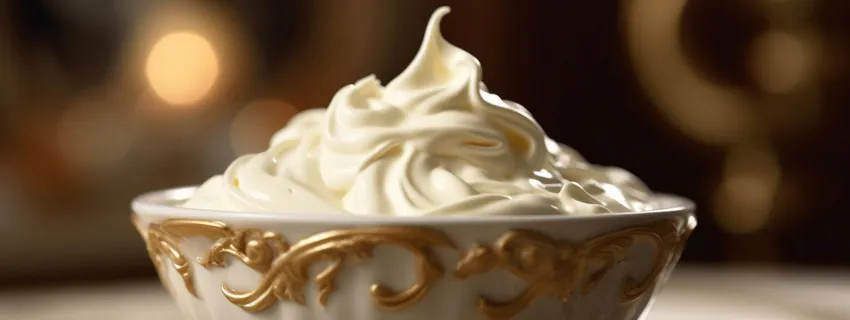
Stuffed Pandoro.
In the last few years, it has become fashionable to fill Pandoro: if, on one hand, this affects the ‘austere character’ of the specialty, on the other enriches it with new flavors, making it even more delicious.
Read more
Among the variants impossible not to mention the one with Mascarpone cream, undoubtedly the most classic, the one with eggnog cream, and the one with Chantilly cream. There is no shortage of ‘exotic’ alternatives, such as pistachio, Limoncello, or coconut cream.

What are the differences between Pandoro and Panettone ?
Pandoro and Panettone are an essential duo during the ‘culinary Christmas’ of the Italian people. The two desserts, in many respects, are related: their dough, for example, is prepared with more or less the same ingredients, as easily understandable from the following list:
Pandoro: flour, eggs, butter, powdered sugar, milk, vanilla, yeast;
Panettone: flour, eggs, butter, sugar, raisins, candied citrus fruit, yeast;
What makes the difference between the two specialties is the different type of processing, which decisively influences characteristics such as:
Read more
THE ASPECT:
Pandoro: tall, with a truncated cone shape and an eight-pointed section, similar to a star;
Panettone: lower, cylindrical, with a typical ‘domed’ top;
THE CONSISTENCY:
Pandoro: the dough is fine, full of small alveoli that make it soft and almost ‘silky’ on the palate;
Penettone: the alveoli of its dough are wider, soft, and elastic;
THE AROMA:
Pandoro: hints of butter, sugar, and vanilla above all;
Panettone: the typical flavor of a leavened dessert, enriched by sugary and bittersweet notes due to the presence of raisins and candied fruit;
THE CALORIES:
Pandoro: 390 kcals (per 100g);
Panettone: 330 kcals (per 100g);
What really distinguishes the two desserts from each other is their personality.
Pandoro is slender, elegant, austere, best suited to refined and discerning palates.
Panettone is robust, exuberant, warm, suitable for those that consider Christmas an occasion of conviviality.

Calories and nutritional values.
It goes without saying that Pandoro, as great part of the specialties served during the Christmas celebrations, is not exactly ‘dietetic’. Here follows a short list showing the calories and nutritional values per 100g of this delicacy:
- Calories 400kcal (ca.)
- Carbohydrates 26gr (ca.)
- Sugars 24gr (ca.)
- Fats 19gr (ca.)
- Proteins 8gr (ca.)
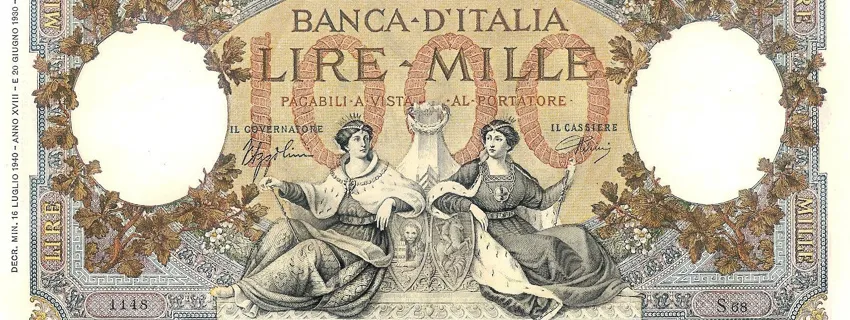
The '1000 lire challenge’.
The recipe for Pandoro patented by Domenico Melegatti in October 1894. His dessert achieved a quick and overwhelming success: not surprisingly, a large number of pastry chefs tried to imitate it, despite the legal act.
Read more
For this reason Mr. Domenico provokingly offered 1000 lire (a considerable sum at the time) as a prize for anyone who could to show up with a perfect copy of his delicious invention. Needless to say that the odd ‘competition’ was deserted.
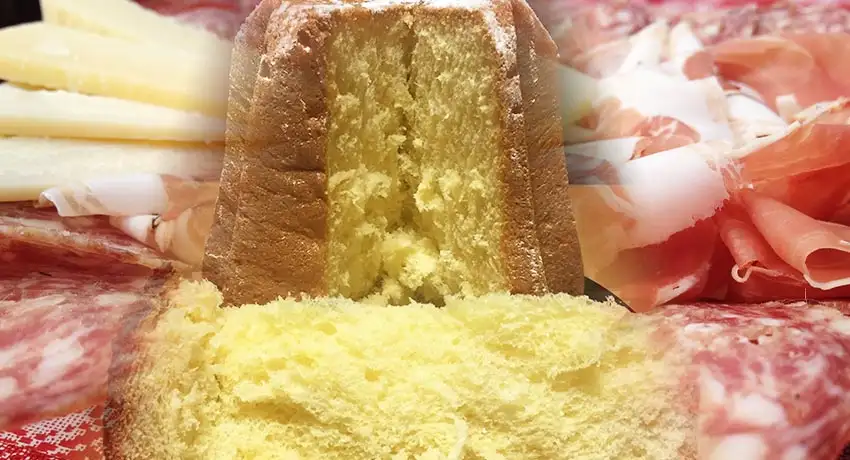
Pandoro for Tiramisù.
The ‘official’ recipe for Tiramisù, one of the best known and most appreciated Italian desserts, includes Ladyfungers (‘Savoiardi’) among its ingredients. Deviating from tradition, Italians sometimes replace the famous biscuits … with slices of Pandoro, perhaps those left over from the Christmas meals.
Read more
The slices, arranged in a baking dish, are moistened with coffee and covered with a tasty mascarpone cream and bitter cocoa powder.
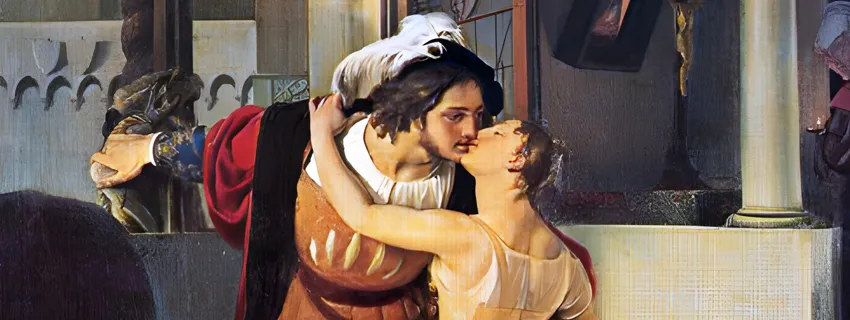
Copyright information.
The images displayed in this page belong to WebFoodCulture, with the exception of:
Public Domain Images
- Melegatti Pastry Shop, Verona, 19th Century (Wikipedia Link)
- The last kiss, Francesco Hayez, 1823 (Wikipedia Link) {PD-Art} {PD-US}
Creative Commons Images
- Portrait of Cangrande della Scale, XVII Century, image by Frn_Brz (Wikipedia Link)
- 1000 Lire ‘Regina del mare’, immage by Hypergio (Wikipedia Link)




